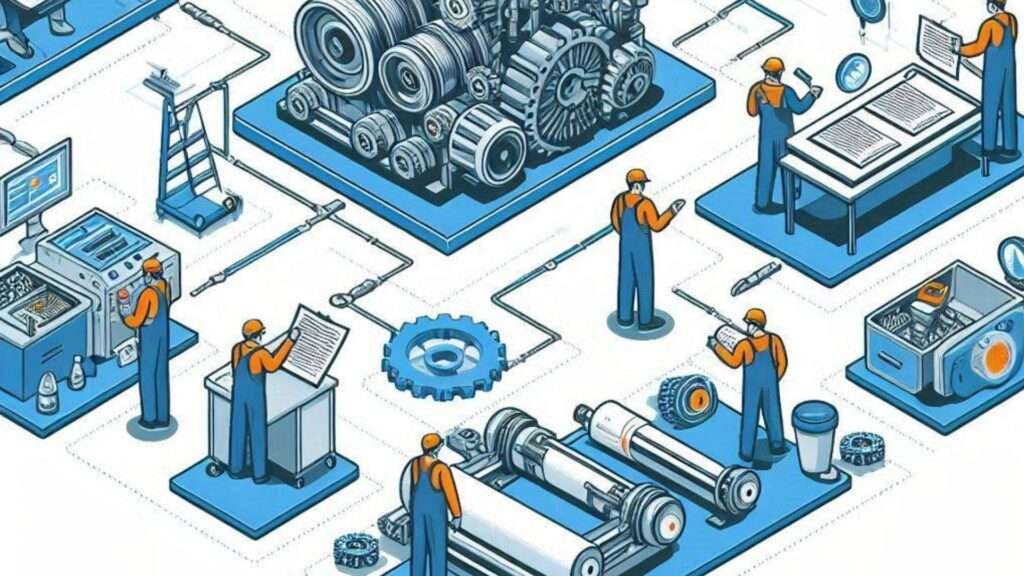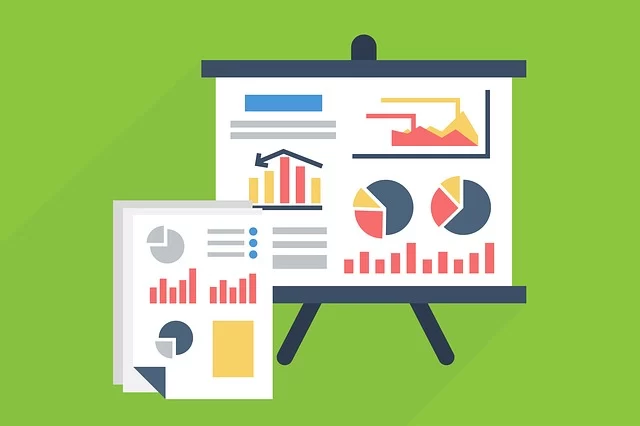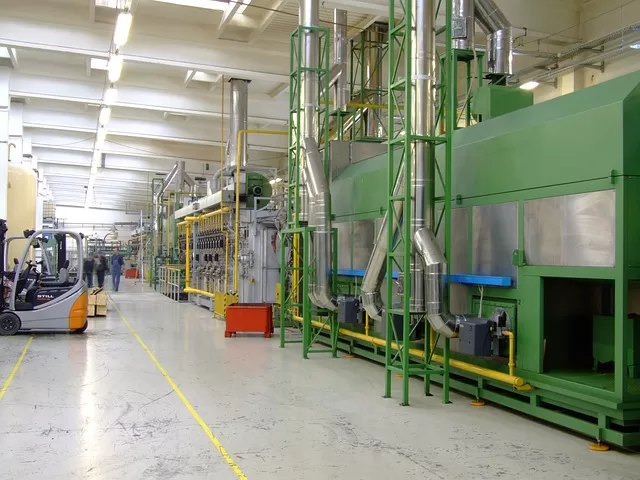Understanding Enterprise Resource Planning Systems.
ERP systems are critical for businesses with complex operations, high-value assets, and stringent regulatory requirements.
It integrates critical processes, improves efficiency, ensures compliance, and provides data-driven insights, resulting in better decision-making and competitive advantage in challenging industries.
Enterprise Resource Planning (ERP) systems have emerged as indispensable tools, and these comprehensive software solutions are typically well-designed to integrate business processes, promoting seamless collaboration and efficiency across departments.
Companies/Industries that I think would most benefit from an ERP system are typically those with significant investments in physical assets or complex operations such as:
1. Manufacturing Companies: Heavy industry, automotive and electronics, manufacturers rely heavily on equipment uptime for production and to be competitive.
2. Utility Companies: Electricity, water and gas providers all need to maintain extensive infrastructure networks.
3. Oil and Gas Companies: From offshore platforms, to refineries and pipelines, they have many high-value assets in challenging environments and these are typically very heavily regulated industries.
4. Mining Companies: Heavy machinery, processing plants, they are sometimes remotely located operations with high downtime costs and are also very heavily regulated companies.
5. Transportation and Logistics: Airlines, railways, shipping companies where fleet management and maintenance are critical business drivers.
6. Facilities Management: Large commercial buildings, campuses and hospitals as they often have complex HVAC, electrical, and safety systems.
7. Aerospace and Defense: Aircraft manufacturers and defense contractors as they operate high-precision equipment with very strict maintenance requirements.
· The aerospace industry has complex supply chains, strict quality control, lots of regulatory compliance requirements, very high value assets, precision manufacturing requirements, data analytics requirements and complex financial management requirements involving long term contracts and international transactions.
8. Pharmaceuticals and Life Sciences: Manufacturing and laboratory equipment has strict regulatory compliance needs.
9. Food and Beverage Production: Production lines, cold storage and distribution networks have very strict food safety and quality assurance requirements.
10. Wind farms & Solar plants: These can have geographically dispersed assets requiring constant monitoring.
11. Municipalities and Government Agencies: Public infrastructure and vehicle fleets all need to be managed effectively; they have diverse assets and must be managed efficiently as they are spending public funds.
12. Large-scale Agriculture: Farm equipment and irrigation systems, they have seasonal operations with critical timing requirements.
These industries typically share characteristics such as:
1. High capital investment in assets.
2. Significant costs associated with downtime.
3. Complex maintenance requirements.
4. Safety-critical operations.
5. Regulatory compliance needs.
6. Geographically dispersed assets.
7. Large-scale operations where small efficiency gains translate to significant savings.
For these types of companies, a quality ERP system that is used effectively can lead to substantial improvements in operational efficiency, cost reduction, and asset longevity, ultimately impacting the bottom line and competitive positioning.
One industry in particular that would greatly benefit from a quality Enterprise Resource Planning System is the Oil and Gas industry, they are very heavily regulated and I think an ERP would assist them in various ways such as:
1. Regulatory Compliance: ERP systems can be configured to ensure operations align with Federal and State regulations like the Offshore Petroleum and Greenhouse Gas Storage Act, the National Greenhouse and Energy Reporting Act, and various other state-specific regulations. They can automate compliance reporting, reducing the risk of human error and potential penalties.
2. Environmental Management: ERPs can track and report on environmental impacts, crucial for meeting a country’s stringent environmental protection laws.
3. Safety Management: Given the high-risk nature of oil and gas operations, ERP systems can help manage safety protocols, incident reporting, and safety training records.
4. Asset Integrity Management: ERPs can ensure that all equipment meets safety standards and is maintained according to regulations.
5. Financial Reporting: These systems can help with accurate financial reporting, crucial for meeting a country’s securities exchange requirements for listed companies.
6. Supply Chain Management: ERPs can help manage the complex supply chains in the oil and gas industry, ensuring compliance with local content requirements and other regulations.
7. Human Resource Management: They can help manage workforce compliance, including work visas for foreign workers, which is common in the oil and gas sector.
8. Document Management: ERPs can maintain a centralized repository for all documentation required for audits and inspections by regulatory bodies.
9. Project Management: For large-scale projects common in the industry, ERPs can ensure all aspects comply with regulations and internal governance policies.
10. Data Analytics: ERPs can provide insights that help companies proactively address potential compliance issues before they become problems.
11. Change Management: As regulations evolve, ERP systems can help companies quickly adapt their processes to remain compliant.
Given the complexities of the oil and gas industry’s regulations and the serious consequences of noncompliance (including financial penalties, operational shutdowns, and reputational damage), a quality ERP system is not only beneficial but frequently required.
It can provide the necessary structure, visibility, and control to ensure that all operations comply with external regulations as well as internal governance policies.
A good ERP system incorporates features from finance, human resources, supply chain management, customer relationship management, and other areas, resulting in a unified platform for managing an organization’s different aspects.
ERP systems are important because they provide a consolidated view of business data, which is essential for making sound decisions.
ERP solutions eliminate data silos by centralising information, ensuring that critical data is accessible in real time across the organisation.
This integration not only boosts operational efficiency, but it also promotes strategic planning and agility, enabling businesses to respond quickly to market changes and opportunities.
ERP systems also increase process efficiency by automating routine tasks, reducing manual intervention, and minimising errors.
This automation covers a wide range of business functions, including order processing, inventory management, and payroll, all of which are built into the ERP framework.
As a result, businesses can increase productivity and save money, which helps to drive overall business growth.
Another important feature of ERP systems is their ability to scale. As businesses evolve, so do their operational requirements.
A properly configured ERP system can adapt to these changes, allowing for expansion and new business models without necessitating a complete overhaul of the software infrastructure.
This scalability ensures that the ERP solution is still a useful and robust tool, regardless of the organization’s size or industry.
In essence, implementing an ERP system is a strategic decision that can lead to long-term success for businesses.
ERP systems help businesses optimise their operations, improve collaboration, and increase efficiency by providing a consistent and integrated approach to business process management.
It becomes evident that these systems are essential to attaining long-term business success as we dig deeper into the transformative potential of properly configured ERP solutions.
Reasons Why An ERP Might Not Be The Right Option For Your Business.
ERP systems may have some disadvantages for some kinds of businesses, despite their amazing and extensive features.
Their intrinsic complexity is one of the main issues. Since reengineering current processes to conform to the new system’s framework is a necessary step in the implementation process, it frequently takes a considerable amount of time and money.
Due to this intricacy, deployment times may be extended and may even take years. During this time, regular business operations may be interrupted.
Another significant disadvantage of ERP systems is their high cost. These expenses cover not only the initial purchase price but also recurring costs like maintenance, customisation, and training.
These financial obligations might be especially taxing on small and medium-sized enterprises, possibly outweighing the system’s long-term advantages.
Issues with integration are also frequently encountered when deploying ERP. Making sure the ERP system integrates seamlessly with the hardware and software infrastructure that already exists for a business can be difficult at times.
This can result in data silos, which defeat the entire intent of the ERP system by keeping information dispersed and unaccessible across departments.
ERP implementations become even more complex due to customisation issues. ERP systems are meant to be flexible, but they might not be able to meet every company’s specific requirements right out of the box.
It can be difficult and expensive to modify the system to meet unique needs; this is because it frequently calls for specialised technical knowledge that isn’t always readily available internally.
Continuous maintenance is an essential component that should not be disregarded. For ERP systems to stay secure and operational, they need regular patches, updates, and technical assistance.
This constant need for maintenance may put a pressure on internal resources and result in extra expenses.
These disadvantages may make ERP systems an overkill solution for smaller businesses.
It’s possible that the benefits will outweigh the complexity, high costs, and significant resource demands, making simpler, more specialised solutions a better fit.
Evaluating Whether Your Business Needs an ERP System.
Making the difficult choice of whether your company needs an enterprise resource planning (ERP) system can be challenging.
In my view, not every kind of business will profit from such an all-inclusive solution, and a number of things need to be taken into account before this investment is made.
The size of the operations is one important factor. An ERP system may be unnecessary for small to midsize businesses, especially if their operations are simple and can be handled by more straightforward software.
For these smaller businesses, the complexity and expense of implementing ERP may not justify the return on investment.
Budgetary restrictions also have a big impact. ERP systems can be costly to install, buy, and maintain.
This expense might not be feasible for companies with few funding sources.
Alternatively, these companies might gain more from scalable, modular software solutions that handle particular requirements without the prohibitive expense and complexity of an entire ERP system.
The applicability of an ERP system is also influenced by industry-specific requirements. An ERP system’s powerful features may be necessary in some industries, like manufacturing or large-scale distribution, to handle complex supply chains, inventories, and production schedules.
Nonetheless, niche markets or service-oriented businesses may discover that their needs are better satisfied by specialised software solutions that address their unique operational requirements.
Businesses can effectively assess their needs by using a checklist to help with this decision-making process. Take into account the following standards:
1. Do you require real-time departmental integration?
2. Is the software you use now unable to keep up with the expansion of your company?
3. Do you have inefficiencies as a result of different systems?
4. Does the system require a lot of customisation or features unique to one industry?
A simpler, more affordable software solution might be a better option if the majority of these questions have a “no” response.
Through careful consideration of these variables, companies can determine if they actually need an ERP system or if a more customised, less expensive option will do.
Exploring Alternatives to ERP Systems.
ERP systems provide deep integration across a range of business operations, but they might not be the best fit for every company, especially smaller ones or ones with specialised requirements.
Thankfully, there exist multiple feasible substitutes that offer the required features without encumbrances of exorbitant expenses, intricate setup, and prolonged upkeep.
Software systems that are modular are one such option. These systems give companies the option to choose and use just the modules that are necessary for running their operations.
By taking a selective approach, businesses can scale their systems gradually as they expand and avoid being overtaken by superfluous features.
A company might, for example, begin with a financial management module and then incorporate modules for inventory control or customer relationship management (CRM).
Because of their adaptability, modular software products offer an affordable and scalable option.
Cloud-based business management solutions are another option that seems very promising. Similar to ERP systems, these platforms provide a number of tools, but they also have the advantages of easier deployment and less initial cost.
Cloud-based solutions are especially beneficial for companies looking for remote accessibility and scalability.
They frequently have subscription-based pricing structures, which are easier for smaller businesses to handle.
Furthermore, the cloud infrastructure relieves businesses of the burden of internally managing IT resources by guaranteeing regular updates and maintenance.
Small Computerised Maintenance Management Systems (CMMS) are a great substitute for companies that prioritise asset and maintenance management.
Preventive maintenance can be scheduled, work orders can be managed, and maintenance operations can be streamlined with CMMS software.
These systems are a sensible option for companies that prioritise maintenance efficiency because they are usually less expensive and simpler to implement than comprehensive ERP systems.
While ERP systems have advantages, more specialised and scalable options are available to meet specific business needs without the complexity or high costs associated with traditional ERP implementations.
Examples of these alternatives include small CMMS, cloud-based solutions, and modular software.
Businesses can find the best fit for their operational needs and financial constraints by carefully weighing these options.
Implementing an ERP for a Newly Established Business.
For newly established businesses, implementing a high-quality Enterprise Resource Planning (ERP) system is not only a recommendation, but a requirement.
Startups and small businesses face unique challenges, necessitating efficient and scalable solutions.
Limited resources, both financial and human, necessitate a system that can optimise operations without exceeding the company’s capabilities.
An ERP system can help solve these problems by providing a centralised platform for managing various business processes.
A new business will benefit from integrating its main business functions, such as finance, human resources, supply chain management, and customer relations, into a single, cohesive system from the start.
By seamlessly integrating all of these processes, a new business can reduce redundancies and increase workflow efficiency.
This integration ensures that data flows smoothly between departments, resulting in improved coordination and collaboration.
Scalability is another important consideration for new businesses. As a startup grows, its operational requirements will change. A strong ERP system can grow with the business, accommodating larger data volumes and more complex processes.
This scalability ensures that the ERP system remains a valuable asset as the company grows, rather than becoming a bottleneck impeding progress.
Furthermore, implementing an ERP system early in the business cycle can result in long-term benefits. Improved efficiency and streamlined operations result in better decision-making.
With real-time data and analytics at their disposal, business leaders can make informed decisions that drive growth and profitability.
Furthermore, an ERP system can improve customer relations by providing a holistic view of customer interactions and preferences, allowing for more personalised and effective service.
A high-quality ERP system is essential for new businesses looking to overcome early challenges and achieve long-term growth.
An ERP system lays the groundwork for increased efficiency, better decision-making, and more opportunities for growth by centralising and optimising critical business processes.
Engaging an ERP Implementation Company: Key Considerations.
When embarking on the journey of implementing an ERP system for a newly established business, choosing the right ERP implementation firm is critical.
The importance of an ERP implementation partner cannot be overstated, as they bring specialised expertise, industry knowledge, and the technical skills required to tailor the ERP system to your company’s needs.
First and foremost, consider the ERP implementation firm’s experience. An experienced company will have a proven track record of successful ERP deployments, lowering the risk of project failure.
Look for firms with extensive industry experience, as they will be better able to understand your company’s unique challenges and requirements.
Industry knowledge is another important factor. An ERP consulting firm that has previously worked with businesses similar to yours will be better able to provide relevant insights and solutions.
Examine client testimonials and case studies to determine the firm’s capability and dependability. Positive feedback from previous clients can provide reassurance that the company can keep its promises.
The vetting process for ERP implementation providers should be comprehensive. Examine their methodologies to ensure they are consistent with your project objectives and timelines.
Effective methodologies should include a well-defined, structured approach to implementation phases, from initial planning to post-deployment support.
Assess the firm’s support services, as ongoing assistance is critical for addressing any issues that may arise after the system goes live.
Post-implementation support is also an important consideration. A competent ERP implementation company will provide comprehensive post-deployment services such as training, troubleshooting, and system optimisation.
These services ensure that your team can use the ERP system effectively and that the system adapts to your changing business needs.
To form a successful partnership with the ERP implementation company, maintain open communication and establish clear expectations from the start. Regular progress meetings and transparent reporting can help the project stay on track.
You can enable a seamless and successful ERP deployment and set up your company for growth and success by carefully choosing and working with an ERP implementation company.
The Comprehensive ERP Implementation Process.
Implementing an Enterprise Resource Planning (ERP) system in a new business requires a meticulously planned, multi-phase process.
The journey typically starts with the initial planning and requirement analysis stage. During this phase, project stakeholders, including business leaders and IT specialists, work together to define the project’s scope, identify key requirements, and establish realistic timelines.
This foundational step ensures that the ERP system is in line with the company’s strategic goals and operational requirements.
The subsequent critical phase is system selection and configuration. This includes selecting the best ERP software for the company’s needs and configuring it to meet specific organisational processes.
Customisation and configuration are critical because they tailor the ERP system to the specific needs of the business, resulting in optimal functionality.
This stage may also include integrating the ERP system with other software applications to create a cohesive IT environment.
Comprehensive system testing (regression and user acceptance) is performed to ensure that all ERP system modules function properly and meet the defined requirements.
Regression testing is typically performed before user acceptance testing (UAT) when implementing a new ERP system and below is an overview of both processes:
1. Regression Testing: Regression testing is done to ensure that new configurations or customizations haven’t negatively impacted existing functionality and it involves:
a. Testing core functionalities to ensure they still work as expected
b. Verifying integrations between different modules
c. Checking data flow and accuracy across the system
d. Ensuring reports and analytics are still accurate
e. Validating system performance under various conditions
The goal of regression testing is to catch any unintended consequences of the new configuration before moving to UAT.
2. User Acceptance Testing (UAT): UAT is performed after regression testing and involves end-users testing the system to ensure it meets their business requirements and it typically includes:
a. Creating test scenarios based on real business processes
b. End-users executing these scenarios in the system
c. Verifying that the system behaves as expected for each scenario
d. Documenting any issues or discrepancies found
e. Testing edge cases and unusual situations, Ensuring the system is user-friendly and efficient for daily use.
UAT is crucial because it validates that the ERP system not only works technically but also meets the specific needs of the business users.
Both stages are critical for ensuring a smooth and successful ERP implementation and minimal hassles upon going live.
The final phase is the go-live and post-implementation support. This stage marks the official launch of the ERP system within the organization.
Adequate training for end-users is essential to ensure they are proficient in using the new system.
Post-implementation support is also vital, as it addresses any unforeseen issues and ensures the system operates smoothly.
Continuous monitoring and incremental improvements may be necessary to optimize the system further and align it with evolving business processes.
Throughout the entire ERP implementation process, robust project management and active involvement of key stakeholders are imperative.
Effective communication, clear goal-setting, and regular progress reviews help maintain the project’s momentum and ensure its successful completion.
Business process reengineering may also be required to align existing processes with the capabilities of the ERP system, ensuring the organization derives maximum value from the implementation.
Ensuring Successful ERP User Adoption and Training.
The successful implementation of an Enterprise Resource Planning (ERP) system in a newly established business hinges significantly on user adoption and training.
Comprehensive ERP user training programs and effective employee on-boarding strategies are vital to familiarizing staff with the new system, thereby ensuring seamless integration and utilization.
Understanding the principles of change management for ERP implementation is crucial. Effective communication stands at the forefront, ensuring that all stakeholders are informed about the benefits and impacts of the new system.
Engaging stakeholders early and often can foster a sense of ownership and reduce resistance.
Managing resistance, a common challenge in ERP adoption, requires empathetic leadership and clear articulation of the advantages the system brings to individual roles and the organization at large.
Best practices for maximizing ERP utilization involve a blend of continuous learning opportunities, performance monitoring, and feedback mechanisms.
Continuous learning can be facilitated through regular training sessions, workshops, and e-learning modules tailored to various user roles.
Performance monitoring helps identify areas where users may struggle, allowing for targeted training interventions.
Feedback mechanisms, such as surveys and user forums, provide valuable insights into user experiences and areas for improvement.
Ongoing support and training are paramount to ensuring long-term success and a substantial return on investment.
This includes establishing a helpdesk or support team to address user queries and issues promptly.
Regular system updates and refresher training sessions can help users stay proficient and adapt to any changes or upgrades in the ERP system.
A strategic approach to user adoption and training is essential for the successful implementation of an ERP system.
By prioritizing comprehensive training programs, embracing change management principles, and fostering a culture of continuous learning and support, newly established businesses can maximize the benefits of their ERP investments and achieve sustainable operational efficiencies.
Maximizing Asset Value, Effectiveness, and Efficiency with ERP.
A well-configured Enterprise Resource Planning (ERP) system can revolutionize the management of a company’s assets, driving both value and efficiency to unprecedented levels.
One of the most significant benefits of an ERP solution lies in its capability to offer real-time tracking of assets.
This real-time visibility ensures that companies can accurately monitor the status, location, and utilization of their assets at any given moment.
Such comprehensive tracking allows for proactive decision-making, minimizing downtime and enhancing productivity.
The goals of asset management and a quality ERP system are closely intertwined, creating a synergy that enhances overall business performance and below is how they align:
Lifecycle Tracking.
· Asset Management Goal: Monitor assets from acquisition to disposal.
· ERP Contribution: Provides integrated tools to track financial and operational aspects of assets throughout their lifecycle.
Maintenance Optimization.
· Asset Management Goal: Minimize downtime and maximize asset availability.
· ERP Contribution: Offers scheduling, work order management, and predictive maintenance capabilities.
Cost Control.
· Asset Management Goal: Optimize asset-related expenses.
· ERP Contribution: Provides detailed cost tracking and analysis for informed decision-making.
Regulatory Compliance.
· Asset Management Goal: Ensure adherence to industry regulations.
· ERP Contribution: Automates compliance tracking and reporting.
Performance Analysis.
· Asset Management Goal: Evaluate asset performance and ROI.
· ERP Contribution: Delivers robust analytics and reporting tools for performance metrics.
Resource Allocation.
· Asset Management Goal: Efficiently allocate resources for asset management.
· ERP Contribution: Offers integrated resource management across the organization.
Risk Management.
· Asset Management Goal: Identify and mitigate asset-related risks.
· ERP Contribution: Provides data and tools for risk assessment and management.
Strategic Planning.
· Asset Management Goal: Align asset strategies with business objectives.
· ERP Contribution: Offers a holistic view of operations for informed strategic decisions.
Data Integration.
· Asset Management Goal: Centralize asset information.
· ERP Contribution: Serves as a single source of truth for all business data, including assets.
Continuous Improvement.
· Asset Management Goal: Constantly enhance asset management practices.
· ERP Contribution: Provides data and tools for ongoing analysis and process improvement.
By aligning these goals, a quality ERP system becomes an indispensable tool for effective asset management, driving operational efficiency and strategic advantage.
The better you setup you ERP and optimize your business processes, the higher return on investment (ROI) you’ll get and better overall performance you will enjoy.
Centralized asset management through ERP also means that different departments can access and share critical asset information seamlessly, fostering collaboration and reducing redundancies.
The financial benefits of a well-implemented ERP system are substantial. By enhancing asset management, companies can achieve significant cost savings through reduced maintenance expenses, minimized downtime, and improved asset longevity.
Additionally, the increased efficiency and productivity that result from optimized asset utilization contribute to a stronger bottom line.
A quality ERP system not only streamlines asset management but also drives overall business success by ensuring that all resources are used effectively and efficiently.
Future-Proofing Your Business with ERP.
A well-configured ERP system that is utilized effectively is instrumental in future-proofing a business by ensuring sustainability, agility, and resilience.
As market conditions, regulatory requirements, and technological advancements continue to evolve, an ERP solution can help companies adapt swiftly and efficiently.
The integration of ERP systems provides a robust framework for navigating these changes, allowing businesses to remain compliant with regulations while leveraging new technologies to enhance operational efficiency.
As your business grows, your ERP system can expand to accommodate increased demands without compromising performance.
This scalability is essential for maintaining continuity and avoiding the disruptions that can occur when systems become outdated or overwhelmed.
ERP systems offer real-time data and analytics, which enable businesses to respond quickly to market trends and customer demands.
This agility is crucial for maintaining a competitive edge in an ever-changing business landscape.
Because ERP solutions facilitate collaboration across departments, you’re ensuring that all parts of the organization are aligned and working towards common goals.
To leverage ERP systems effectively, companies must prioritize regular updates and customizations to meet their specific needs.
This ongoing investment will ensure that the ERP system remains relevant and effective in the long term.
By embracing a well-configured ERP solution, businesses can build a resilient foundation that supports sustainable growth, enhances agility, and drives innovation, ultimately securing their place in the future market.
Consider the high quality ERP Software Suite offered by Pronto Software.
Pronto Xi is an integrated ERP software suite developed by Pronto Software, a leading Australian company.
Designed to streamline business operations, Pronto Xi encompasses a range of core modules that collectively support various business processes.
Each module is tailored to address specific operational needs, thereby enabling businesses to enhance efficiency and productivity.
One of the foundational modules of Pronto Xi is Financials, which provides robust capabilities for managing financial transactions, budgeting, and reporting. This module ensures accurate financial data and compliance with regulatory standards, making it indispensable for businesses seeking precise financial oversight.
The Supply Chain module within Pronto Xi offers comprehensive tools for inventory management, procurement, and logistics.
By optimizing supply chain activities, businesses can reduce costs and improve service levels. This module is particularly beneficial for industries that rely heavily on inventory management and distribution.
Manufacturing is another critical module in Pronto Xi, designed to support production planning, scheduling, and execution.
This module enhances manufacturing efficiency by providing real-time visibility into production processes, ensuring that resources are utilized effectively.
The Sales and Marketing module equips businesses with tools to manage customer relationships, sales orders, and marketing campaigns.
This module helps businesses to drive growth by improving customer engagement and streamlining sales processes.
Pronto Xi also includes a Business Intelligence module, which empowers organizations with data analytics and reporting capabilities.
This module enables businesses to make informed decisions by providing insights into key performance indicators and trends.
One of the standout features of Pronto Xi is its flexibility and scalability. The software can be customized to meet the unique needs of small to medium-sized businesses across various industries such as manufacturing, retail, distribution, and services.
This adaptability ensures that Pronto Xi can grow alongside a business, accommodating increased complexity and scale over time.
Pronto Xi’s integrated approach and comprehensive core modules make it a powerful ERP solution that supports the diverse operational needs of modern businesses. By leveraging these modules, organizations can achieve greater efficiency, insight, and competitive advantage.
Implementation, Pricing, and Deployment Options.
Adopting Pronto Xi involves a strategic approach to ensure a smooth transition and maximize the benefits of this integrated ERP software suite.
One of the first considerations for businesses is the pricing structure of Pronto Xi. Compared to other ERP solutions available in the market, Pronto Xi offers a competitive pricing model that varies based on the specific modules and functionalities a business requires.
This modular pricing approach allows companies to tailor their investment according to their unique needs, making it a cost-effective ERP solution.
The implementation timeframe for Pronto Xi is dependent on several factors including the complexity of the business processes, the number of modules being implemented, and the level of customization required.
Generally, the implementation process can range from a few months to over a year. Critical to a successful implementation are thorough planning, adequate training, and continuous support from both the vendor and internal IT teams.
Pronto Xi offers flexible deployment options to cater to different business preferences. Companies can choose between on-premises deployment, which provides greater control over the infrastructure and data, or cloud-based deployment that offers benefits like scalability, reduced IT costs, and remote accessibility.
The cloud-based option, in particular, is gaining popularity due to its ability to support mobile access, which is a growing necessity in today’s business environment.
Mobile access is a significant feature of Pronto Xi, enabling users to access the ERP system from virtually anywhere, thus enhancing productivity and decision-making capabilities.
Pronto Software ensures that Pronto Xi is regularly updated with software updates and new feature releases, keeping it aligned with evolving business needs and technological advancements. These updates are seamlessly integrated, minimizing disruption to business operations.
Overall, businesses considering Pronto Xi can expect a robust and flexible ERP solution, backed by competitive pricing, adaptable deployment options, and ongoing support to ensure successful implementation and sustained operational efficiency.
Integration, Customization, and User Experience.
Pronto Xi excels in its integration capabilities, seamlessly connecting with a variety of third-party applications to enhance its core functionalities.
The software supports integration with popular customer relationship management (CRM) systems, e-commerce platforms, and other enterprise resource planning (ERP) tools, ensuring that businesses can create a cohesive ecosystem tailored to their operational needs.
The system requirements for Pronto Xi are designed to be flexible, accommodating both on-premises and cloud-based deployments.
This flexibility ensures that businesses of all sizes can leverage Pronto Xi without encountering significant technical barriers.
Being able to Personalize and Customize is a standout feature of Pronto Xi, allowing businesses to modify the software to align with their unique processes and workflows.
Users can adjust modules, create custom reports, and implement specific business rules without extensive coding knowledge.
This level of customization ensures that Pronto Xi can adapt to various industry requirements, from manufacturing to retail and beyond.
The platform’s user-friendly interface further enhances its appeal, offering intuitive navigation and straightforward access to essential functions.
This design consideration is particularly beneficial for non-technical users, who can quickly become proficient with minimal training.
Data security and compliance are critical components of Pronto Xi’s architecture.
The software incorporates advanced encryption standards and multi-layered security protocols to safeguard sensitive business data.
Additionally, Pronto Xi is designed to comply with various regulatory standards, such as GDPR and industry-specific mandates, providing businesses with the assurance that their data is handled with the utmost care. This would surely make it a great option for Oil and Gas Companies.
Regular updates and patches further ensure that the system remains resilient against emerging threats.
Overall, Pronto Xi’s robust integration capabilities, extensive customization options, user-friendly interface, and stringent data security measures make it a versatile and reliable ERP solution.
These features collectively contribute to an enhanced user experience, enabling businesses to operate more efficiently and securely.
Pronto Xi’s Business Intelligence and Market Position.
Pronto Xi distinguishes itself in the realm of ERP software through its integrated business intelligence (BI) tools.
These built-in BI capabilities are designed to deliver comprehensive reporting and analytics, empowering organizations to make data-driven decisions.
Unlike standalone BI tools that often require complex integrations, Pronto Xi’s BI tools are seamlessly incorporated into the system, ensuring real-time access to critical data.
This holistic integration allows users to generate detailed reports, perform in-depth analytics, and derive actionable insights without the need for additional software.
When comparing Pronto Xi’s BI tools to standalone BI solutions, the advantages become evident.
The seamless integration within the ERP framework reduces the time and effort needed to consolidate data from disparate sources.
This integration enhances the accuracy and reliability of the information, enabling businesses to react swiftly to market changes and operational challenges. By providing a unified platform for both ERP and BI, Pronto Xi simplifies the decision-making process, making it more efficient and effective.
In terms of market share, Pronto Xi has carved out a significant niche in the ERP industry, particularly in Australia.
It is highly regarded for its ability to cater to the unique needs of small to medium-sized enterprises (SMEs).
Globally, while competing with giants like SAP and Oracle, Pronto Xi maintains a competitive edge through its specialized focus on flexibility, cost-effectiveness, and scalability.
Its market position is bolstered by a strong reputation for customer satisfaction and robust performance.
I think one of the key advantages of Pronto Xi over larger ERP providers is its cost structure. Pronto Xi offers a more affordable solution without compromising on functionality, making it an attractive option for SMEs.
Additionally, the flexibility of Pronto Xi allows for customization to meet specific business requirements, a feature that is often limited in more rigid ERP systems like SAP or Oracle.
Scalability is another significant benefit, as Pronto Xi can grow alongside the business, adapting to increasing complexities and demands.
In Conclusion.
If you want to modernise your operations and streamline your asset management processes, investing in a comprehensive Enterprise Resource Planning (ERP) system is a sound strategic decision.
An ERP solution can significantly improve operational efficiency, increase data visibility, and enable informed decision-making across all departments.
While researching ERP options, it’s critical to consider solutions that meet your specific industry needs and future growth plans.
In this context, I believe ProntoXi is well worth researching.
ProntoXi provides a robust set of features that can help you overcome many of your current challenges and position yourself for future success.
Here some of the main points I like about ProntoXi:
It’s a well-designed integrated ERP suite with strong asset management capabilities and other business management tools.
Some key features that could benefit almost any operation are:
1. Comprehensive asset lifecycle management.
2. Predictive maintenance capabilities.
3. Integrated financial management.
4. Advanced reporting and analytics.
5. Mobile accessibility for field teams.
6. Scalability to accommodate our future growth.
ProntoXi is known for its flexibility and user-friendly interface, which could make the transition from your current system easier. If you’re a new business looking for an ERP, this could be a good fit for you.
It also provides cloud and on-premises deployment options, so you can select the best fit for your IT infrastructure.
I believe ProntoXi could significantly improve any organization’s asset management processes and provide valuable insights for strategic decision-making.








